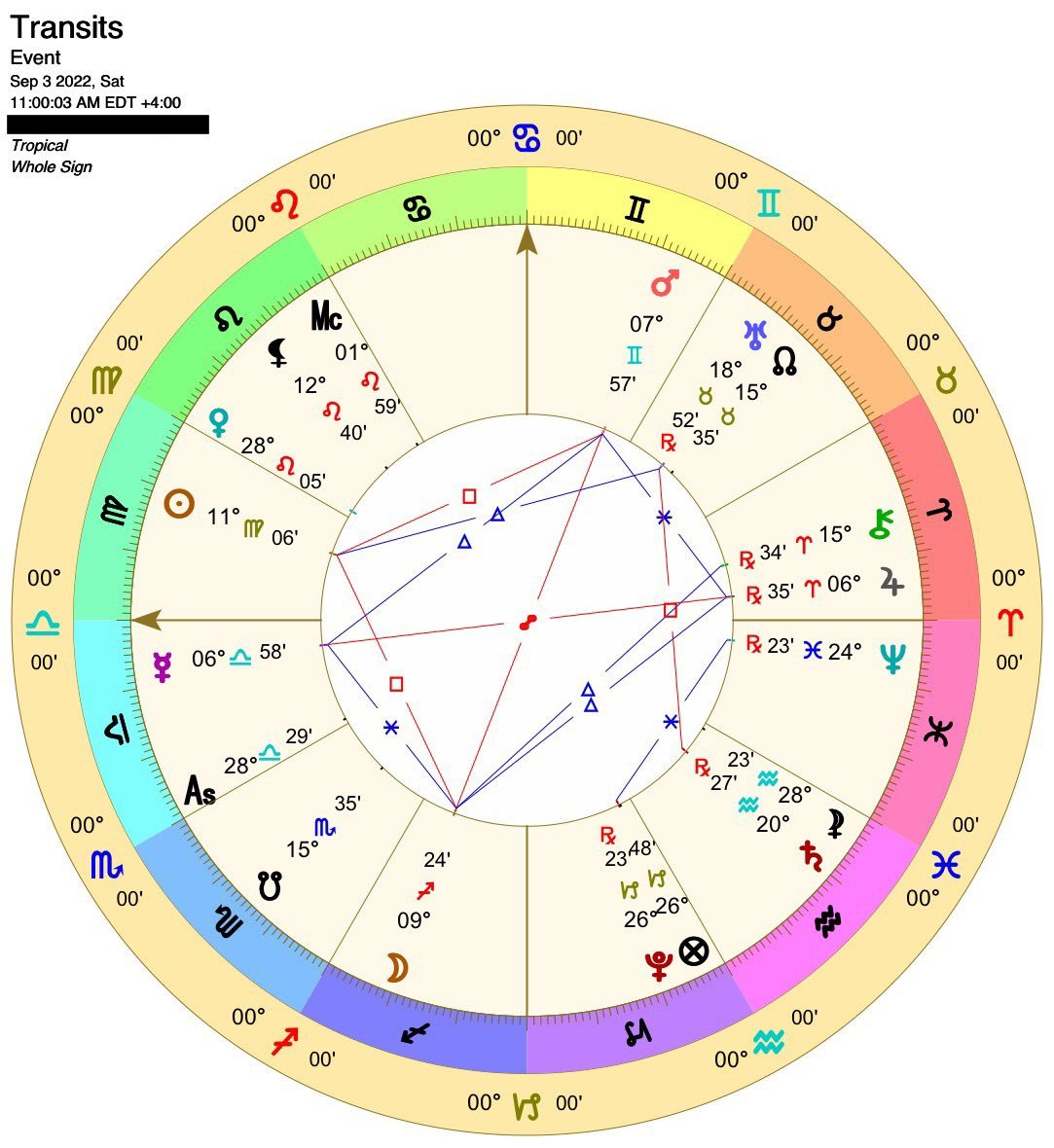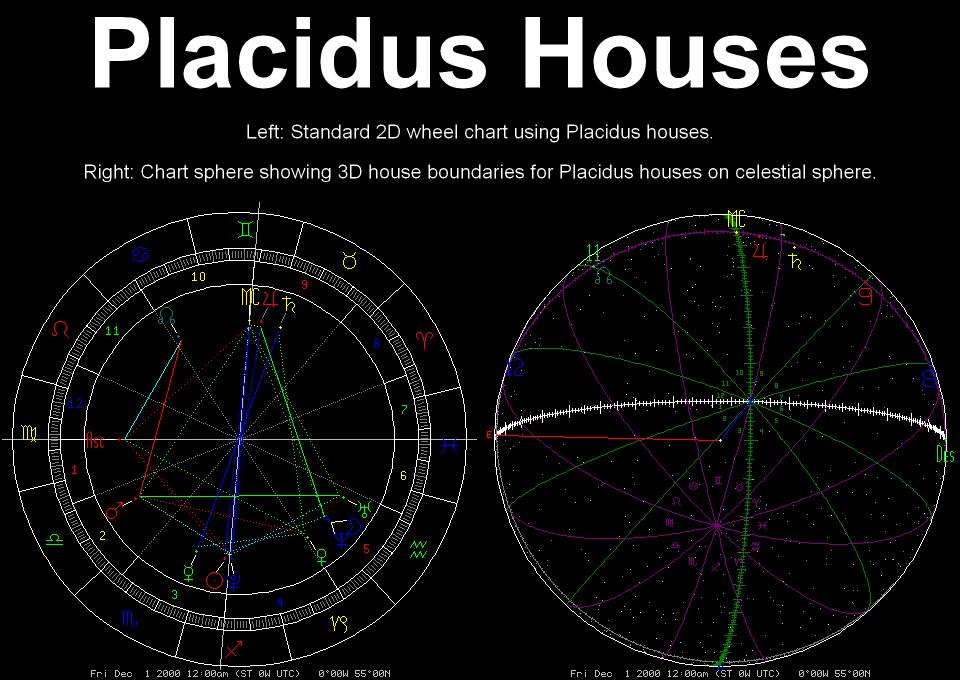House Divisions
In my astrology, I use both whole-sign houses and Placidus cusps at the same time.
(Except on my homework for the horary class I’m in this year, because that would make me get the answers wrong.)
Houses are the component of astrological divination concerned with WHERE a relevant point is in the local sky, and thus what part of the story it represents.
There are many ways to divide it up. I ponder it constantly.
Let’s begin with the standard contemporary disclaimer: No house system is “right.” Any division of the sky — even “degrees” — is obviously a simplification. What matters is how your chosen divisions symbolize YOUR relationship to the sky and function in techniques YOU use.
On a basic level, “where” something is in the sky requires no elaboration. It’s over there. It’s up there. It’s rising in the east. It’s setting in the west. It’s under the Earth. These observations and their intuitive meaning-tones are the basis of astrological house division.
More precision than that only becomes necessary as techniques of delineation become more complex and precise. The history — which I have learned mostly from Deborah Houlding, Chris Brennan, and Demetra George — is one of the melding of a profusion of lineages for doing this.
An overarching takeaway from how this has gone over the millennia, to me, is that it is impossible to do astrology for very long without discovering the continuity of space and time. Diurnal motion — i.e. “where” the Sun is — is the definition of conventional time, after all.
So different ways of functionally dividing the sky for observation have arisen, some based on spatial definitions, and some based on temporal ones. Both go as far back as it goes, historically. In my own budding practice, I’ve found I need both at once. Here’s my rationale:
My foundation is in traditional Hellenistic technique. (Why THAT is is way out of scope here.) I am convinced by the coherence of the techniques, planetary rulerships and joys, aspects to the ascendant from 30º divisions, etc, of the symbolic power of whole-sign houses.
I am also convinced of their historicity, and that much confusion has resulted from the fact that Hellenistic authors often weren’t distinguishing between “houses” and “domiciles” ON PURPOSE, because in those techniques, houses were simply numbered by which SIGN was where.
Whole-sign houses name the sign currently rising as the first house and proceed around the zodiac. Couldn’t be easier. That’s part of the appeal. As shown in the graphic above, the geometry of this is also elegant, with aspects from cusps to the ascendant describing house strength.
The rising and setting signs are powerful places, naturally, as they are where the planetary temples of the ecliptic make contact with the ground where the observer stands. If the zodiac is the mythic journey of the planets through the year, the local horizon places YOU in it.
Going back to the idea of houses as divination upon WHERE we’re looking, the WHERE of whole-sign houses is a local perspective on the 30º segments of the ecliptic each tradition (in its own way) has described as the COSMIC places of the planets. A NARRATIVE “where,” if you will.
But recalling that pesky spacetime continuum, there’s something missing from this view. Since the ecliptic declines from the equator — the circle along which the Earth actually rotates — the zodiac alone is not an ideal instrument for knowing WHEN a point will be WHERE.
This has a consequence for whole-sign houses. While aspects to the ascendant are neat descriptions of strength, they aren’t the only one, and one of the most powerful is ANGULARITY — whether a house is applying to or falling from an angle. WSH only reliably shows half that story.
The asc/dsc is fine, but also the north/south meridian intersects the ecliptic at the highest (the “midheaven”) and lowest points (the “angle of earth, i.e. straight underground) in the local sky. The 4th and 10th SIGNS from the ascendant don’t always contain those points.
That’s because the ecliptic does not move in a circle from a point on the surface of the Earth; different parts rise in different amounts of time and at different angles. Knowing when a particular degree of the ecliptic (and any planet present) will be where is funkier than that.
So this is why quadrant house systems exist. They use the ascendant/descendant as the 1H/7H cusps, the MC/IC as the 10H/4H cusps, and they divide those quadrants into thirds all kinds of ways. This way, the houses in the chart show the local ANGULARITY of the ecliptic degrees.
There are an ungodly number quadrant house divisions. Again, no system of doing this is “right” or “wrong.” It depends on YOUR PRACTICE. And to be clear, most astrologers only use ONE SYSTEM, trad or modern, WSH or quad. LUCKY THEM. I have only considered two:
The relatively recent horary tradition — which I am studying — uses Regiomontanus houses, probably because William Lilly did, and it was the most popular system at the time (1600s). Pre-iPad, calculating house cusps was laborious, so you used the one you could get the book for.
It is always a desperate search for me to find a living astrologer’s personal symbolic rationale for why they use a particular house system, and “because so-and-so did” does not do it for me. I have been using Regio in my horary class, but begrudgingly until recently.
On this Astrology Podcast episode about medical astrology, which uses similar techniques, Marcos Patchett AT LAST offered one I loved, which is that Regio projects the BODY of the Earth into space, which seems like a cool thing to do for astrology about bodies.
Regiomontanus divides the EQUATOR into 12 equal slices, so like imagine 12 vertical orange slices rotating with the Earth. You look up from where you are at that big gear clicking through the sky, and the way it slices up the ecliptic from your local angle gives you the houses.
What I have liked about using Regio this year is that a chart really FEELS like space. Regio charts provide a nice 2D representation of how your local POV moves through its visible VOLUME of sky.
Thing is, while that is how I like to do ASTRONOMY, it doesn’t symbolize how I do astrology. I want my measurements of angularity to be rooted in time. That’s how I relate to the sky’s motion throughout the day, and what it means to me. So I’ve decided to break from Tradition™.
Placidus is a time-based system that’s easy to explain. Each degree of the ecliptic has a “diurnal arc,” or an amount of spacetime between when it rises and sets in a place each day (if you aren’t at the North Pole… don’t worry about that for now). Placidus divides THAT up.
A day is the diurnal arc of the Sun through the sky. Considering that arc as time, divide it by 12, and you get that day’s “solar hours,” which are what astrological “planetary hours” are, how Jewish prayer times are calculated, basically a humane way of keeping time seasonally.
So a Placidus house is two “hours” long. When the Sun is on the cusp of one, or the midpoint of a house, that’s a new hour. Day and night hours are different lengths except on equinoxes, but the day hours are of equal length, and the night hours are of equal length.
This is just a slightly more formal version of profoundly ancient forms of timekeeping, which were certainly used astrologically. Given its deep integration with the rest of my spiritual practice, I just HAVE to use this for the time part of my spacetime. The gods have said so.
Placidus gets a lot of crap because it’s the default setting on most software, and in order to be a cool astrologer, you have to change your settings. In fact, I agree with that, and I did it. But you should change it to something that LANDS with you. So I’ve changed it back.
When I am reading a chart, I use the whole-sign significations for the cosmic/mythic/divine components of an inquiry, of which there are always some. I use quadrant cusps to find significators of more worldly, practical matters, as horary usually calls for. I look at both.
I have to do my homework in Regio for the rest of the year, so I feel like I’ll have plenty of time to see how this settles in for me. And like I said, I still think Regio is a beautiful description of space-as-a-body. There may be a place for that, too. Whichever symbols speak.


